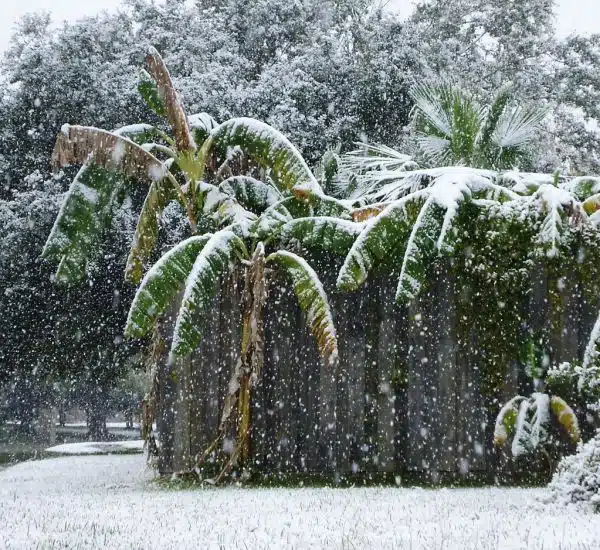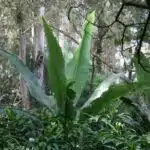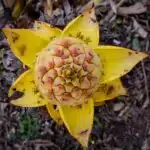Snow banana trees, also known as the Musa velutina, are a unique and fascinating addition to any garden. Their vibrant pink flowers and small, edible fruit make them an attractive option for those looking to cultivate something different. However, caring for these trees can be challenging without proper knowledge and attention.
In this article, we will discuss the various steps necessary for growing and maintaining healthy snow banana trees. This includes soil preparation, watering techniques, fertilization requirements, pruning methods, and pest control measures. By implementing these practices effectively, gardeners can ensure that their snow banana trees thrive year-round and provide a beautiful addition to their landscape.
Choosing The Right Location For Your Snow Banana Tree
Snow banana trees require careful consideration when it comes to selecting the appropriate location for planting. One of the first steps in this process is to test your soil. This is crucial because snow bananas thrive in well-draining, nutrient-rich soils with a pH range of 5.5-6.5. Soil testing will help you determine if your soil meets these requirements or if you need to amend it before planting.
Aside from soil testing, microclimate considerations are also essential in choosing the right location for your snow banana tree. The ideal temperature range for growing snow bananas is between 75-85°F during the day and above 60°F at night, with high humidity levels. Choose an area that gets plenty of sunlight, but not too much direct sunlight as it may cause leaf scorching and dehydration.
It’s important to note that snow banana trees are sensitive to frost, so make sure to avoid planting them in areas with frost pockets or where cold air can settle during winter months. By considering these factors, you can ensure optimal growth and health for your snow banana tree, leading to a bountiful harvest of tasty fruit in due time. Moving on, let’s explore understanding soil requirements for optimal growth.
Understanding Soil Requirements For Optimal Growth
In order to attain optimal growth for your snow banana tree, it is important to understand the soil requirements. Soil pH plays a crucial role in determining the health of your plant. Snow bananas prefer slightly acidic soil with a pH range of 5.5-7.0. Therefore, it is recommended to test your soil and adjust the pH level accordingly.
Apart from pH, drainage requirements are also important factors to consider while planting snow banana trees. These plants require well-draining soil that doesn’t hold excess moisture for long periods of time. Poor drainage can lead to root rot which can be fatal for the plant. To improve drainage, you can add organic matter like compost or sand to the soil mix.
To ensure healthy growth of your snow banana tree, it is essential to provide proper care and maintenance. Understanding the soil requirements including pH levels and drainage requirements are crucial steps towards achieving this goal. In the next section, we will discuss watering techniques and frequency necessary for maintaining these tropical beauties.
Watering Techniques And Frequency
Watering is a crucial aspect of snow banana tree care. These trees are drought-tolerant, but this does not mean they should be neglected when it comes to watering. Adequate watering will ensure optimal growth and yield. The frequency and amount of water required for your snow banana trees depend on various factors such as soil type, weather conditions, and stage of growth.
Snow banana trees require consistent moisture in the soil to ensure proper growth and development of their roots. They do not tolerate standing water or overly saturated soils, so it is essential to avoid overwatering. To retain soil moisture, add a layer of mulch around the base of the tree. This will also help prevent weed growth that competes with the tree for nutrients and water.
To determine when to water your snow banana trees, check the soil’s moisture level by sticking your finger into the top inch of soil. If it feels dry at this depth, it is time to water your trees. During hot summer months, you may need to increase the frequency of watering as evaporation rates are higher during this period. Overall, proper watering techniques will ensure healthy growth and abundant fruit production for your snow banana trees.
Moving forward from proper watering techniques, fertilization needs and schedule are also important aspects of snow banana tree care. By providing adequate nutrients through fertilization, you can ensure healthy growth, robust foliage, and bountiful fruit production for your trees.
Fertilization Needs And Schedule
Some growers may question the use of fertilizers in growing snow banana trees. However, it is important to note that proper fertilization is essential for healthy growth and fruit production. Fertilizers provide nutrients that are necessary for plant growth, such as nitrogen, phosphorus, and potassium. Without these nutrients, plants may become stunted, weak, or even die.
There are two main types of fertilizers: organic and chemical. Organic fertilizers are made from natural sources such as animal manure, compost, or bone meal. These types of fertilizers release nutrients slowly over time and improve soil health by promoting beneficial microbial activity. On the other hand, chemical fertilizers are manufactured from synthetic materials and provide an immediate source of nutrients to the plants.
When applying fertilizer to snow banana trees, it is important to consider the foliar application technique. Foliar feeding involves spraying a liquid fertilizer solution directly onto the leaves of the plant. This method allows for quick absorption of nutrients into the plant tissue and can be especially helpful in correcting nutrient deficiencies.
Pruning for healthy growth and fruit production is another important aspect of caring for snow banana trees. By removing dead or diseased branches, pruning encourages new growth and helps maintain the overall shape of the tree. Additionally, pruning can help increase airflow to reduce disease pressure and ensure proper light penetration for healthy fruit development. With proper pruning techniques and timing, growers can expect a bountiful harvest from their snow banana trees.
Pruning For Healthy Growth And Fruit Production
After implementing a proper fertilization schedule, it is important to focus on pruning techniques for maintaining healthy growth and fruit production in snow banana trees. Pruning is necessary to remove dead or diseased leaves, suckers, and offset shoots that can inhibit the tree’s progress. Additionally, pruning promotes light penetration and air circulation within the canopy, which helps prevent fungal diseases.
To prune snow banana trees properly, start by removing any dead or dying leaves as soon as possible. Next, look for suckers or offset shoots growing from the base of the plant and cut them off immediately. These shoots not only divert nutrients from the main trunk but may also introduce unwanted pests or diseases into the tree. Finally, thin out any overlapping branches to promote more light penetration and air circulation.
Disease prevention is key when caring for snow banana trees. In addition to proper pruning techniques, it is important to keep an eye out for symptoms of common diseases such as Fusarium wilt and Panama disease. Symptoms include wilting leaves and yellowing foliage. To prevent the spread of disease, remove any infected plant material immediately and disinfect your tools before using them on other parts of the tree. By following these simple steps, you can ensure that your snow banana tree will produce healthy fruit year after year.
Moving forward into pest prevention and control measures, it is essential to remain vigilant against potential threats such as aphids or spider mites that can quickly infest a snow banana tree. One effective method of controlling these pests is by introducing natural predators like ladybugs or lacewings into your garden ecosystem. Additionally, regular inspections of your tree’s leaves can help detect any early signs of pest infestation allowing you to take action before significant damage occurs. Remember that prevention is always better than cure when it comes to pest control!
Pest Prevention And Control Measures
It is a common misconception that snow banana trees are not susceptible to pests. Unfortunately, these trees are vulnerable to a variety of insects and diseases that can damage or even kill the plant. The good news is that there are various natural remedies available to prevent and control pest infestations.
One of the most effective ways to prevent pest infestations is by maintaining proper hygiene around the tree. This includes removing any dead leaves, fruit, or other debris from around the base of the plant. It is also important to keep the soil around the tree well-drained and free from standing water as this can attract pests like mosquitoes.
If you do notice signs of a pest infestation, it is crucial to act quickly before it spreads and causes irreparable damage. There are various natural remedies that you can use such as neem oil, garlic spray, and soap sprays. However, in severe cases where natural remedies are not effective, it may be necessary to seek professional extermination services.
Overall, preventing and controlling pest infestations in snow banana trees requires vigilance and diligence. By following proper hygiene practices and utilizing natural remedies when necessary, you can maintain a healthy tree without resorting to harmful chemicals. In the next section, we will discuss how to properly harvest and use snow banana fruit for maximum enjoyment.
Harvesting And Using Snow Banana Fruit
Snow banana trees (Musa nivis) are a cold-tolerant species of banana tree that produce a yellow, custard-like fruit. When harvesting snow bananas, the fruit should be picked once the peel has started to turn yellow and the fruit is soft to the touch. Snow bananas must be prepared for eating by peeling away the skin and slicing the fruit into bite-sized pieces before consuming. Snow bananas can be used in a variety of dishes, from sweet desserts to savory salads and main dishes. The leaves of the snow banana tree can also be used to wrap food before cooking, as they are large, flexible, and non-toxic. Snow banana flowers can be cooked and eaten as a side dish or added to soups and stews.
Harvesting Snow Bananas
When it comes to harvesting snow bananas, timing is everything. Waiting until the fruit reaches full maturity ensures that you will have a sweet and tasty treat. Snow banana trees typically produce fruit in late fall or early winter, so it’s important to keep an eye on the tree during this time. The fruit should be harvested when it turns yellow and begins to soften.
To harvest the snow bananas, simply cut them off of the tree with pruning shears or a sharp knife. Once you have harvested all of the fruit, place them in a cool, dry place for a few days to ripen fully. You can tell that they are ready to eat when they are soft and fragrant. After this stage, you can start incorporating them into your favorite snow banana recipes.
Not only do snow bananas taste great, but they are also packed with health benefits. They contain high levels of vitamin C and potassium, both of which promote heart health and help prevent chronic diseases such as cancer and diabetes. Their low glycemic index also makes them a good option for those watching their blood sugar levels. So go ahead and indulge in some delicious snow banana recipes while reaping all of these amazing health benefits!
Preparing Snow Bananas
After harvesting snow bananas at the right time, the next step is to prepare them properly. Snow bananas can be eaten raw or cooked, and there are several ways to prepare them for consumption. Before preparing snow bananas, it’s important to wash them thoroughly with clean water to remove any dirt or debris that may be on the fruit.
When it comes to cooking snow bananas, there are many recipes to choose from. They can be grilled, baked, fried, mashed or sautéed. Some popular recipes include banana bread, banana pancakes, banana fritters and banana smoothies. To make these recipes even more nutritious, you can add other fruits and vegetables such as berries, spinach or kale.
To ensure that your snow banana trees continue to produce high-quality fruit year after year, it’s important to use proper planting techniques and provide them with the proper nutritional requirements. Make sure that you plant your trees in well-drained soil and provide them with plenty of sunlight and water. Additionally, fertilize your trees regularly with a balanced fertilizer that contains nitrogen, phosphorus and potassium. By following these simple steps, you can enjoy delicious snow bananas for years to come!
Using Snow Bananas
After learning how to harvest snow bananas and prepare them for consumption, it’s time to explore the various ways of using this nutritious fruit. Snow banana recipes are aplenty and can be modified to suit any palate. From sweet to savory dishes, snow bananas can be used in many ways that will tantalize your taste buds.
One popular way of using snow bananas is by making banana bread or pancakes. These recipes are simple to follow and require minimal ingredients, making them a favorite among those who love baking. Additionally, snow bananas can also be used in smoothies or as a topping for cereal or oatmeal, adding a sweet and creamy flavor.
Apart from their delicious taste, snow bananas offer numerous health benefits as well. They are rich in vitamins A and C, potassium, fiber, and antioxidants. Consuming snow bananas regularly can lower blood pressure, aid digestion, boost immunity, and improve heart health. Incorporating this superfood into your diet can lead to overall better health and well-being.
In conclusion, using snow bananas is not only delicious but also offers many benefits for your health. With the abundance of recipes available online or in cookbooks, incorporating this versatile fruit into your meals is easy and enjoyable. So next time you have ripe snow bananas on hand, try experimenting with different recipes to reap their numerous health benefits while satisfying your cravings!
Overwintering And Protection From Cold Temperatures
Winter Protection and Frost Prevention
Snow banana trees are tender and sensitive to cold temperatures. Therefore, they require winter protection to survive freezing conditions. Before the onset of winter, it is essential to prepare your snow banana tree for the cold season. A layer of organic mulch around the base of the tree can help protect the roots from frost heaving and keep them warm during the winter months.
In addition to mulching, you can also use protective coverings such as burlap or blankets to shield your snow banana tree from cold winds and frost. Covering the entire plant with an insulating material can trap heat inside and maintain a warmer environment for your tree during freezing temperatures. It is important to note that covering should be removed during sunny days to avoid overheating.
To prevent damage from frost, it is crucial to monitor temperature changes regularly. When there is a possibility of frost, water your snow banana tree thoroughly before sunset. Watering helps retain heat in the soil, providing warmth through the night. In case there is still a risk of frost damage despite all prevention measures taken, consider using anti-transpirants spray on leaves and stems as they reduce water loss through transpiration.
Tips for Winter Protection:
Apply a thick layer of organic mulch around the base of your snow banana tree.
Use protective coverings such as blankets or burlap around your plant to shield it from wind and frost.
Tips for Frost Prevention:
Monitor temperature changes regularly.
Water your snow banana tree thoroughly before sunset when there is a possibility of frost.
Moving on from winter protection and frost prevention measures, propagation methods for snow banana trees are equally important in taking care of these plants throughout their lifecycle.
Propagation Methods For Snow Banana Trees
As we have discussed earlier, providing adequate protection to snow banana trees during winter is a crucial step in ensuring their healthy growth. However, once the frosty weather passes and warmer temperatures arrive, it’s time to think about propagating new plants. There are two primary ways to propagate snow banana trees: indoor propagation and outdoor propagation.
Indoor propagation involves starting new plants from seeds or suckers indoors in containers filled with well-draining soil. The ideal temperature for germination is around 80°F, which can be achieved by using heat mats or placing the containers near a heat source. Once the seedlings have grown two to three leaves, they can be transplanted into larger pots or directly into the garden if the outdoor temperatures are warm enough.
Outdoor propagation involves planting suckers directly into the ground. Suckers are small shoots that emerge from the base of mature snow banana trees and can be separated from the parent plant when they are at least a foot tall. Before planting them outside, make sure to amend the soil with organic matter such as compost or aged manure to promote healthy growth.
In conclusion, propagating snow banana trees is relatively easy and can be done both indoors and outdoors using seeds or suckers. By following these methods, you can expand your collection of snow banana trees and enjoy their beautiful foliage all year round. In the next section, we will discuss some common issues that may arise when growing and caring for these plants along with their solutions.
Troubleshooting Common Issues And Solutions
Snow banana trees are low-maintenance plants, but like any other plant, they can encounter issues that may cause them to become unhealthy. Common diseases that affect snow banana trees include bacterial wilt, fusarium wilt, and Panama disease. Bacterial wilt is caused by the bacterium Ralstonia solanacearum and affects the vascular system of the plant. Fusarium wilt is caused by the fungus Fusarium oxysporum and causes yellowing of leaves and stunted growth. Panama disease is also caused by a soil-borne fungus and causes wilting and yellowing of leaves.
Pest management is an essential part of caring for snow banana trees. The most common pests that affect these plants include mealybugs, spider mites, aphids, and whiteflies. Mealybugs are small insects covered in a white waxy substance that feed on the sap of the plant. Spider mites are tiny arachnids that suck sap from leaves, causing yellowing and brown spots on the foliage. Aphids are small insects that feed on new growth causing deformities in leaves and stems. Whiteflies are tiny flying insects that suck sap from leaves causing them to turn yellow or brown.
To prevent common diseases and pests from affecting snow banana trees, it’s important to maintain good hygiene practices such as removing dead or diseased tissue promptly, avoiding overwatering, keeping weeds under control, and using clean tools when pruning or trimming the plant. Additionally, chemical control measures such as insecticides or fungicides may be necessary if natural methods fail to control infestations adequately. By following these tips, you can help ensure your snow banana tree stays healthy and free from pests and diseases for years to come.
- Regularly inspect your snow banana tree for signs of disease or pest infestation.
- If you notice any signs of infestation or infection take prompt action.
- Use organic methods first before resorting to chemical control methods.
- Always follow instructions carefully when applying any chemical control measures.
Remember, caring for your snow banana tree is an essential part of ensuring it thrives in your garden or home. By following these tips and practicing good hygiene practices, you can help prevent common diseases and pests from affecting your plant. Regular inspection and prompt action are crucial to maintaining a healthy tree, so be sure to keep an eye out for any issues and take immediate steps to address them.
Conclusion
Snow banana trees, also known as Musella lasiocarpa, are a beautiful and exotic addition to any garden. To ensure optimal growth and fruit production, it is important to choose the right location with adequate sunlight and soil conditions. Understanding the soil requirements and providing proper watering techniques and fertilization schedules can also aid in the tree’s health.
Pruning is essential for maintaining healthy growth and promoting fruit production. Harvesting snow banana fruit requires patience as it may take up to two years for the plant to bear fruit. Overwintering techniques must also be implemented to protect the tree from cold temperatures. Propagation methods include division of rhizomes or use of seeds.
Despite its unique beauty, snow banana trees can face common issues such as pest infestations or fungal diseases. However, with proper care and attention these issues can be avoided or remedied. By following these guidelines, any horticultural enthusiast can successfully grow and care for a snow banana tree in their own backyard.
Image Credits
- “Snow Falling on Banana Palms, Humble, Texas, December 4, 2009” by Patrick Feller (featured)





























